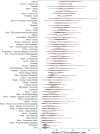The Parkinson's Disease Genome-Wide Association Study Locus Browser
- PMID: 32864809
- PMCID: PMC7754106
- DOI: 10.1002/mds.28197
The Parkinson's Disease Genome-Wide Association Study Locus Browser
Abstract
Background: Parkinson's disease (PD) is a neurodegenerative disease with an often complex component identifiable by genome-wide association studies. The most recent large-scale PD genome-wide association studies have identified more than 90 independent risk variants for PD risk and progression across more than 80 genomic regions. One major challenge in current genomics is the identification of the causal gene(s) and variant(s) at each genome-wide association study locus. The objective of the current study was to create a tool that would display data for relevant PD risk loci and provide guidance with the prioritization of causal genes and potential mechanisms at each locus.
Methods: We included all significant genome-wide signals from multiple recent PD genome-wide association studies including themost recent PD risk genome-wide association study, age-at-onset genome-wide association study, progression genome-wide association study, and Asian population PD risk genome-wide association study. We gathered data for all genes 1 Mb up and downstream of each variant to allow users to assess which gene(s) are most associated with the variant of interest based on a set of self-ranked criteria. Multiple databases were queried for each gene to collect additional causal data.
Results: We created a PD genome-wide association study browser tool (https://pdgenetics.shinyapps.io/GWASBrowser/) to assist the PD research community with the prioritization of genes for follow-up functional studies to identify potential therapeutic targets.
Conclusions: Our PD genome-wide association study browser tool provides users with a useful method of identifying potential causal genes at all known PD risk loci from large-scale PD genome-wide association studies. We plan to update this tool with new relevant data as sample sizes increase and new PD risk loci are discovered. © 2020 The Authors. Movement Disorders published by Wiley Periodicals LLC on behalf of International Parkinson and Movement Disorder Society. This article has been contributed to by US Government employees and their work is in the public domain in the USA.
Keywords: GWAS; Parkinson's disease; prioritization.
© 2020 The Authors. Movement Disorders published by Wiley Periodicals LLC on behalf of International Parkinson and Movement Disorder Society. This article has been contributed to by US Government employees and their work is in the public domain in the USA.
Figures





References
Publication types
MeSH terms
Grants and funding
- HHSN268201100037C/HL/NHLBI NIH HHS/United States
- HHSN268201800011C/HL/NHLBI NIH HHS/United States
- R01 HL117626/HL/NHLBI NIH HHS/United States
- R01 HL095080/HL/NHLBI NIH HHS/United States
- N01HC85080/HL/NHLBI NIH HHS/United States
- UL1 RR024989/RR/NCRR NIH HHS/United States
- UL1 TR000445/TR/NCATS NIH HHS/United States
- R01 MH094714/MH/NIMH NIH HHS/United States
- HHSN268201800012I/HB/NHLBI NIH HHS/United States
- R21 DA027021/DA/NIDA NIH HHS/United States
- HHSN268201800012C/HL/NHLBI NIH HHS/United States
- K24 HL105780/HL/NHLBI NIH HHS/United States
- R01 HL092217/HL/NHLBI NIH HHS/United States
- U54 HG003067/HG/NHGRI NIH HHS/United States
- Z01 AG000949/ImNIH/Intramural NIH HHS/United States
- R01 HL083141/HL/NHLBI NIH HHS/United States
- R01 HL121007/HL/NHLBI NIH HHS/United States
- U01 HL080295/HL/NHLBI NIH HHS/United States
- R21 MH103877/MH/NIMH NIH HHS/United States
- HHSN268201500001C/HL/NHLBI NIH HHS/United States
- R01 HL120393/HL/NHLBI NIH HHS/United States
- UM1 HG008895/HG/NHGRI NIH HHS/United States
- HHSN268201800014I/HB/NHLBI NIH HHS/United States
- R01 HL104156/HL/NHLBI NIH HHS/United States
- U01 MH103365/MH/NIMH NIH HHS/United States
- R01 HL092577/HL/NHLBI NIH HHS/United States
- R01 HL068986/HL/NHLBI NIH HHS/United States
- R01 HL043851/HL/NHLBI NIH HHS/United States
- HHSN268200800007C/HL/NHLBI NIH HHS/United States
- R01 HL085251/HL/NHLBI NIH HHS/United States
- U19 HL065962/HL/NHLBI NIH HHS/United States
- R01 HL066216/HL/NHLBI NIH HHS/United States
- K24 AG000949/AG/NIA NIH HHS/United States
- Z01 ES101986/ImNIH/Intramural NIH HHS/United States
- U01 HL089897/HL/NHLBI NIH HHS/United States
- R01 HL089856/HL/NHLBI NIH HHS/United States
- N01HC85082/HL/NHLBI NIH HHS/United States
- U54 HG003273/HG/NHGRI NIH HHS/United States
- U01 HL065962/HL/NHLBI NIH HHS/United States
- ZIA NS003154/ImNIH/Intramural NIH HHS/United States
- U01 MH103392/MH/NIMH NIH HHS/United States
- K23 HL071632/HL/NHLBI NIH HHS/United States
- HHSN268201800014C/HL/NHLBI NIH HHS/United States
- R01 HL090620/HL/NHLBI NIH HHS/United States
- U01 HL089856/HL/NHLBI NIH HHS/United States
- N01HC55222/HL/NHLBI NIH HHS/United States
- U01 MH103346/MH/NIMH NIH HHS/United States
- RC2 HL101651/HL/NHLBI NIH HHS/United States
- R01 MH105472/MH/NIMH NIH HHS/United States
- HHSN268201700002C/HL/NHLBI NIH HHS/United States
- N01HC85083/HL/NHLBI NIH HHS/United States
- HHSN268201200036C/HL/NHLBI NIH HHS/United States
- P30 DK072488/DK/NIDDK NIH HHS/United States
- HHSN268201800001C/HL/NHLBI NIH HHS/United States
- HHSN268201700001I/HL/NHLBI NIH HHS/United States
- HHSN268201800013I/MD/NIMHD NIH HHS/United States
- HHSN268201500015C/HL/NHLBI NIH HHS/United States
- N01HC85086/HL/NHLBI NIH HHS/United States
- MRC_/Medical Research Council/United Kingdom
- U01 MH103340/MH/NIMH NIH HHS/United States
- HHSN268201700004I/HL/NHLBI NIH HHS/United States
- R01 HL111314/HL/NHLBI NIH HHS/United States
- HHSN268201500001I/HL/NHLBI NIH HHS/United States
- K23 HL076322/HL/NHLBI NIH HHS/United States
- N01HC75150/HL/NHLBI NIH HHS/United States
- N01 HC085079/HL/NHLBI NIH HHS/United States
- U01 MH103339/MH/NIMH NIH HHS/United States
- R01 HL104608/HL/NHLBI NIH HHS/United States
- N01HC25195/HL/NHLBI NIH HHS/United States
- U01 HL072515/HL/NHLBI NIH HHS/United States
- HHSN268201500014C/HL/NHLBI NIH HHS/United States
- R01 CA047988/CA/NCI NIH HHS/United States
- HHSN268201700005C/HL/NHLBI NIH HHS/United States
- HHSN268201700001C/HL/NHLBI NIH HHS/United States
- HHSN268201700003C/HL/NHLBI NIH HHS/United States
- U01 HG004735/HG/NHGRI NIH HHS/United States
- U01 HL120393/HL/NHLBI NIH HHS/United States
- R01 MH105898/MH/NIMH NIH HHS/United States
- R21 MH102791/MH/NIMH NIH HHS/United States
- HHSN268201800015I/HB/NHLBI NIH HHS/United States
- 75N92019D00031/HL/NHLBI NIH HHS/United States
- HHSN268201700004C/HL/NHLBI NIH HHS/United States
- R21 MH105881/MH/NIMH NIH HHS/United States
- UL1 RR024975/RR/NCRR NIH HHS/United States
- HHSN268201700002I/HL/NHLBI NIH HHS/United States
- UM1 HG008898/HG/NHGRI NIH HHS/United States
- HHSN268201800010I/HB/NHLBI NIH HHS/United States
- HHSN268201700005I/HL/NHLBI NIH HHS/United States
- N01HC85081/HL/NHLBI NIH HHS/United States
- R01 AG023629/AG/NIA NIH HHS/United States
- HHSN268201800011I/HB/NHLBI NIH HHS/United States
- R01 HL073410/HL/NHLBI NIH HHS/United States
- R44 TR000045/TR/NCATS NIH HHS/United States
- RC1 HL099355/HL/NHLBI NIH HHS/United States
- HHSN268201700003I/HL/NHLBI NIH HHS/United States
- R01 AG018728/AG/NIA NIH HHS/United States
- K23 HL114724/HL/NHLBI NIH HHS/United States
- R01 HL088119/HL/NHLBI NIH HHS/United States
- P50 MH106934/MH/NIMH NIH HHS/United States

